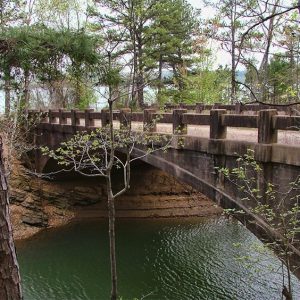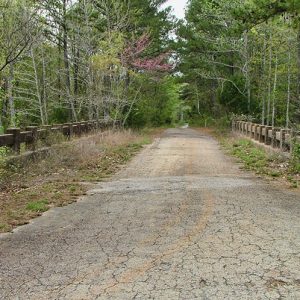calsfoundation@cals.org
Old Highway 16 Bridge
The Old Highway 16 Bridge, located on Lakefront Resort Road near Edgemont (Cleburne County), is a reinforced concrete, closed-spandrel deck-arch bridge built in 1936 with assistance from the Works Progress Administration (WPA), a Depression-era federal relief program. It was listed on the National Register of Historic Places on May 11, 2011.
Edgemont began as the Kinderhook settlement in the mid-nineteenth century but did not thrive until the arrival of the Missouri and North Arkansas (M&NA) Railroad in 1908, after which the town had a bank, three sawmills, a cotton gin, a lumber company, and several restaurants. A result of the railroad construction was the “Edgemont Cut,” which sliced through a steep ridge that ran between Edgemont and the middle fork of the Little Red River. After the railroad’s completion, Highway 16 crossed the tracks at the cut at grade level.
After the WPA was created in 1935, the agency announced an ambitious $6 million road plan for Arkansas, with $3,352,061 set aside for eighty-three highway construction projects and $3,574,060 for sixty-three railroad grade crossing improvements. The latter included construction of a bridge to traverse the Edgemont Cut about a mile uphill from the grade-level crossing, which would be the only overpass ever built to cross the 178 miles of M&NA tracks in the state; all others crossing passed at grade level.
On December 19, 1935, the Arkansas State Highway Commission awarded O. B. Robbins of Heber Springs (Cleburne County) the contract to build Bridge No. 1308, with $7,129.89 set aside for road improvements and $8,440.50 for construction of a “spandrel filled conc[rete] arch” substructure bridge. The agency awarded $1,858.02 for engineering and contingencies, allowing Robbins 180 days to complete the job.
Robbins hired Alvin Rogers as superintendent for the project, with Neal Bryant Garver of the Highway Commission serving as bridge engineer, helped by Louie Thompson of Heber Springs. The project had some initial delays, as reported in the Heber Springs Times-Headlight in February 1936: “Considerable trouble has been experienced in trying to start this project, due to the local W.P.A. trying to get all relief labor properly listed. Some trouble has arisen over the right-of-way at Edgemont, which has caused suspension of work until that can be straightened out.”
Robbins and his crew finished the job well within the 180-day construction window, with the Times-Headlight reporting on July 16 that the “new bridge and road are completed and now open to the public.” The job was completed slightly under budget; Transportation Department records document $6,858.44 spent on road work and $8,605.46 on the bridge.
When Greers Ferry Lake was completed in 1963, Highway 16 was moved about 100 yards north of the bridge, though it continues to serve local traffic in the twenty-first century. Edgemont, too, was moved north to its current location with the original town beneath the surface of the lake.
The completed single-span bridge is 78.5 feet long and 24.0 feet wide, with simple concrete guard rails along its length. By 2020, it was the sole remaining WPA-built concrete deck-arch bridge in Arkansas.
For additional information:
“Arkansas Works Progress Road Program Announced.” Arkansas Gazette, September 15, 1935, P. 17.
“Bridge Record.” Arkansas Department of Transportation files, Little Rock, Arkansas.
Hope, Holly. An Ambition to be Preferred: New Deal Recovery Efforts and Architecture in Arkansas, 1933–1943. Little Rock: Arkansas Historic Preservation Program, 2006. Online at http://www.arkansaspreservation.com/News-and-Events/publications (accessed April 29, 2020).
Stuart, Charles. “Old Highway 16 Bridge.” National Register of Historic Places registration form. On file at Arkansas Historic Preservation Program, Little Rock, Arkansas. Online at http://www.arkansaspreservation.com/National-Register-Listings/PDF/CE0025.nr.pdf (accessed April 29, 2020).
Mark K. Christ
Central Arkansas Library System
 Early Twentieth Century, 1901 through 1940
Early Twentieth Century, 1901 through 1940 Historic Preservation
Historic Preservation Transportation
Transportation Old Highway 16 Bridge
Old Highway 16 Bridge  Old Highway 16 Bridge Construction
Old Highway 16 Bridge Construction  Old Highway 16 Bridge Entrance
Old Highway 16 Bridge Entrance 




Comments
No comments on this entry yet.